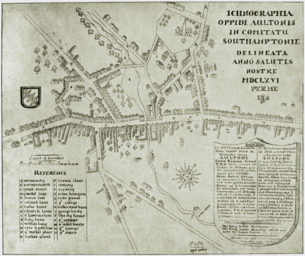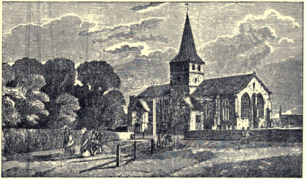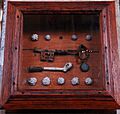Battle of Alton facts for kids
Quick facts for kids Battle of Alton |
|||||||
|---|---|---|---|---|---|---|---|
| Part of First English Civil War | |||||||
|
|||||||
| Belligerents | |||||||
| Commanders and leaders | |||||||
| Sir Ralph Hopton Colonel Richard Boles |
Sir William Waller | ||||||
| Strength | |||||||
| ~1,000: 300–500 horse 600+ infantry |
5,000: Westminster Trained Bands (the Red Regiment) Green Auxiliary Trained Bands of London Tower Hamlets Auxiliary Trained Bands (the Yellow Regiment) A foot regiment (Waller's own) Horse that had survived Roundway Down |
||||||
| Casualties and losses | |||||||
| 100+ 500+ captured |
~10 | ||||||
The Battle of Alton was a key fight during the First English Civil War. It happened on December 13, 1643, in the town of Alton, Hampshire, England. In this battle, the Parliamentary army, led by Sir William Waller, launched a surprise attack. They targeted a winter camp of Royalist soldiers, who were led by the Earl of Crawford.
This battle was the first major defeat for Sir Ralph Hopton, who was the leader of the Royalist forces in the south. It really affected him, especially because he lost many soldiers. After their big win, the Parliamentarians were able to move on and successfully attack Arundel, which was another important Royalist stronghold.
On the morning of December 13, as Waller's army got close to Alton, Crawford quickly rode away with his cavalry (horse soldiers) to Winchester. He left Colonel Richard Boles to defend Alton with only the infantry (foot soldiers). Boles and his men were greatly outnumbered. They were soon forced to hide in the Church of St Lawrence, where they fought bravely until the end. Colonel Boles was killed, along with most of his remaining men. The Parliamentarians won a clear victory, losing only a few of their own soldiers and capturing many Royalists.
Colonel Boles's final stand is remembered for its bravery. Stories say he fought many enemies before he fell. The Battle of Alton is known as one of the "most savage encounters" of the English Civil War. You can still see musket holes from the fight in the south door of the church and inside, where so many soldiers were killed or captured. This battle was also the first time leather guns were used in the English Civil War. Waller's army used them effectively before and during the fight.
Contents
Why the Battle Happened
On September 13, 1643, the English Parliament told Major General William Waller to gather soldiers. Their job was to "protect" Hampshire County. By November, Waller was in charge of forces in Farnham, a main Parliament base. His goal was to control Kent, Surrey, Sussex, and Hampshire.
Waller's army grew with help from London. This included soldiers from the Westminster Red Regiment, the London Green Auxiliaries, and the Tower Hamlets Yellow Auxiliaries. He also had his own foot soldiers and cavalry (horse soldiers) who had survived an earlier battle.
Waller marched from Farnham towards Odiham and Alton. He wanted to take these towns while slowly moving towards Basing. Basing wasn't super important on its own. But it was close to the main road connecting London, Salisbury, and Winchester, so it was worth attention. Waller tried to attack Basing House twice in November but failed. His soldiers were tired and the weather was bad. He then went back to Farnham to wait for Hopton's army.
Sir Ralph Hopton arrived on November 27. King Charles gave him 1,580 horse soldiers. But he only had about 2,000 new foot soldiers and 500 troops who had just returned from fighting in Ireland. Hopton had been told to secure Dorset, Wiltshire, and Hampshire. He also needed to push as far as possible towards London. To do this, Hopton spread his men out across Hampshire. They stayed for the winter in Winchester, Alresford, Petersfield, and Alton. He did this to make sure no single town had too many soldiers to feed. But this also made his army weaker because they were spread out.
Hopton put the Earl of Crawford in charge of Alton. On December 1, Crawford started to build defenses around the small town as fast as he could. Crawford had one cavalry group and one infantry group. The exact number of his men isn't known, but it was probably around 1,000.
Getting Ready for Battle
In the week before the Battle of Alton, Waller secretly scouted the town. He planned his attack carefully, telling only a few of his top officers. On the evening of December 9, Waller sent a small group to raid Crawford's lodging. They pulled back after a small attack.
On the morning of December 12, Crawford sent a message to Waller in Farnham. He asked for a "runlet of sack" (a type of wine), promising an ox in return. When Waller sent the wine, Crawford refused to send the ox. He dared Waller to come get it himself.
Waller was eager to improve his reputation after an earlier defeat. So, he quickly decided to attack Alton. It was the closest Royalist outpost to Farnham, only ten miles away. Reports from that time say that Crawford was only watching the main road from Farnham.
The Battle Begins
Waller gathered his men in Farnham Park around 10:30 p.m. on December 12. Around midnight, 5,000 of Waller's soldiers marched west from Farnham. They marched about two miles in that direction to trick any Royalist scouts. Then, around 1:00 a.m., they suddenly turned south towards Alton. The march was fast and quiet. This was because a long frost had made the roads hard. Waller also used wooded areas to stay hidden. His army also used leather guns, which were new to the English Civil War. These guns were lighter than other cannons. One horse could pull them, making them easy to move over rough ground. They were still powerful for attacking.
Waller's forces reached the west side of Alton around 9:00 a.m. They captured six Royalist guards. However, one Royalist guard managed to warn everyone just before dawn. This allowed Crawford and his horse soldiers to quickly leave Alton and gallop towards Winchester. They reportedly promised the foot soldiers they would return soon with help. Crawford and his cavalry first tried to escape from the east side of Alton. But Waller's horse soldiers forced them back into town and then south, directly towards Winchester. Waller's heavy cavalry, led by Sir Arthur Haslerig (nicknamed the "Lobsters"), chased the fleeing Royalists for half a mile. The Royalists lost some men and horses. Haslerig then stopped chasing and guarded the entrances to the town.
Meanwhile, Colonel Boles's men gathered in the north-west part of town, near the Church of St Lawrence. Some of Waller's soldiers attacked Alton from the north and north-west. The Royalist foot soldiers hid inside buildings and fired quickly. They especially liked a large brick house near the church. But this house was soon abandoned. Waller's cannons, placed at the bottom of a hill to the west, fired at it. This forced the defenders to retreat to the church.
Parliamentary soldiers from London and Farnham Castle came down the hill. Waller's Red Regiment attacked a small fort and a defensive wall the Royalists had built. The Green Regiment went around the Royalists behind these defenses, forcing them out. They marched through town hidden by smoke from a thatched house they had set on fire. Soon after, the rest of Waller's men entered the town. They pushed Boles's men back to the Church of St Lawrence. From the church and nearby defenses, the Royalists held their ground for two hours. They fired from the church windows. They even used scaffolding inside the church to shoot from higher up.
Eventually, the Parliamentarians forced the Royalists to leave part of the wall around the church. The Royalists left their muskets sticking up, so the Parliamentarians didn't know they had left for a short time. Once they realized, the Parliamentary army quickly attacked the churchyard. They pushed the last of Boles's men into the church itself. Waller's soldiers threw hand grenades into the windows while trying to get inside. Inside the church, Boles declared he would kill anyone who first asked to surrender. The Royalists hadn't had time to block the church doors, so the Parliamentarians soon got in. Inside, the Royalists shot from behind a makeshift wall of dead horses. Some of Boles's men were killed; others surrendered. With Boles killed, almost all the remaining Royalists gave up.
After the Battle
During and after the battle, Waller captured at least 500 Royalist soldiers. About 100 of these joined Waller's army. More than 100 Royalist soldiers were killed. Together, these losses meant Hopton lost nearly half of his foot soldiers in the south. Waller, on the other hand, lost only about ten men. His success greatly boosted his reputation.
Waller made his prisoners drag the dead horses out of the church. They also took down the scaffolding inside and buried their fallen friends near the north wall of the building. All the captured men were then marched to Farnham, tied together in pairs.
Waller ordered his men to destroy Alton's defenses. He also had the survivors who didn't join his army paraded through the streets of London to show off his victory. Crawford's hat, cloak, and the wine he was given were all left behind in Alton. From then on, people joked that Crawford, when he fled, "left his sack at Alton." When King Charles heard about Boles's death, he was very sad. He called Boles one of "the best Commanders in this Kingdome."
Hopton was very upset by his defeat at Alton. It affected him more than the military importance of the battle might suggest. For Waller and the Parliamentarians, the victory greatly boosted their spirits. On December 15, the House of Commons of England ordered Sir Arthur Haslerig and Sir Gilbert Gerard to write a letter praising Waller for his success.
The Parliamentarian victory at Alton allowed Waller to move south-east. He then attacked Arundel and successfully besieged the Royalist soldiers there. Hopton couldn't break the siege with his few remaining foot soldiers. The 1,000 horse soldiers he got from Oxford were not enough to help. After the siege of Arundel, both armies had to stop fighting for the winter because of the harsh weather.
Images for kids







